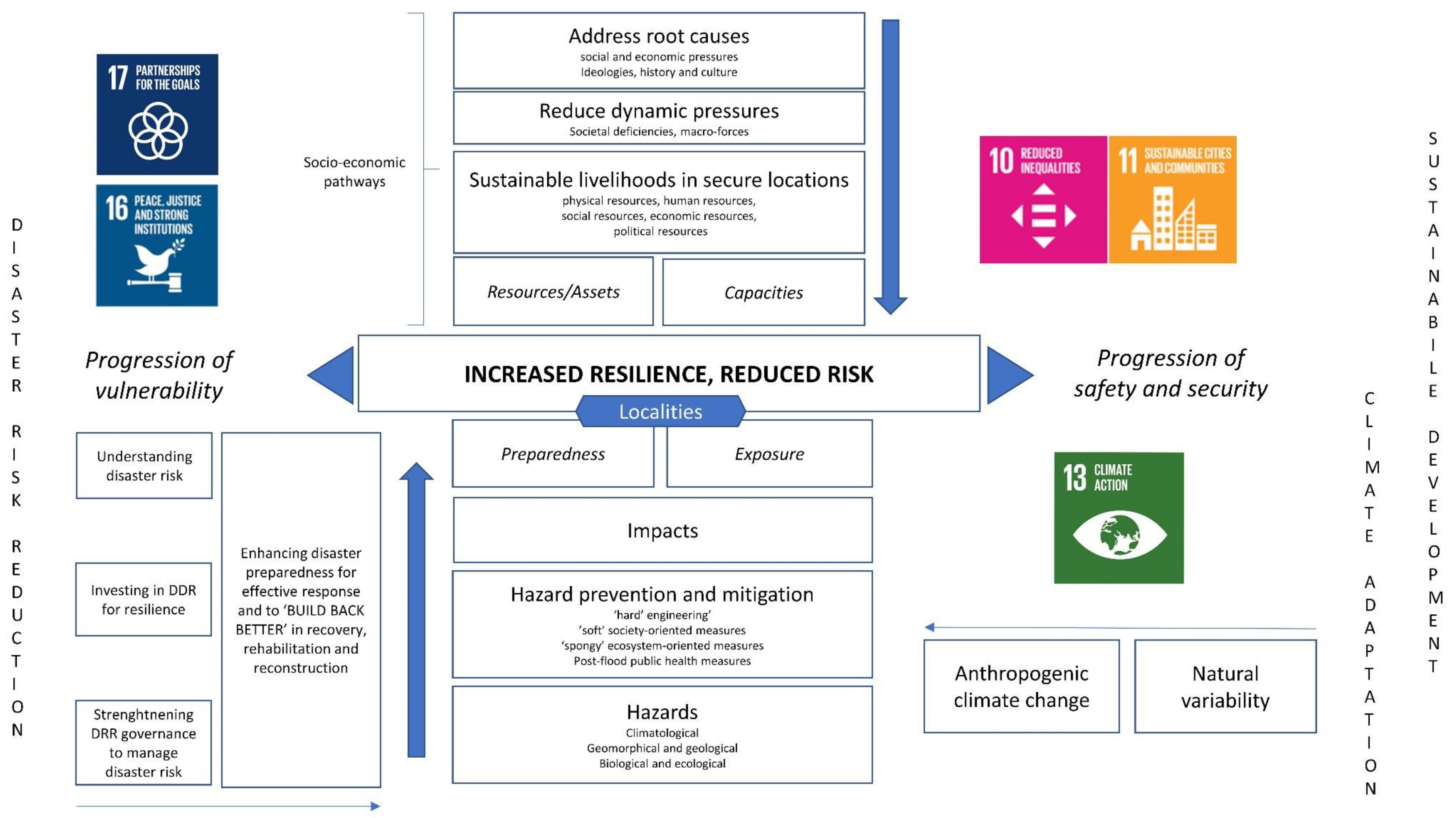Adaptive Capacity as Local Sustainable Development: Contextualizing and Comparing Risks and Resilience in Two Chilean Regions
Abstract
1. Introduction
2. Local and Regional Resilience and Development
3. Methodology
4. Highlighting Regional Differences
The Santiago Metropolitan and Araucania Regions
5. Adaptive Capacity: The Role of Socio-Economic and Socio-Cultural Conditions
5.1. The Santiago Metropolitan Region
5.2. The Araucania Region
6. Episodic and Incremental Risks as a Feature of Regional Development
6.1. The Covid-19 Pandemic in Chile
6.2. The 2010 Earthquake
6.3. Climate Change
7. Conclusions: Risk as Immanent, Resilience as Adaptive Capacity, and Transformation as Sustainable Local Development
Author Contributions
Funding
Institutional Review Board Statement
Informed Consent Statement
Data Availability Statement
Acknowledgments
Conflicts of Interest
References
- Cecioni, A.; Pineda, V. Geology and geomorphology of natural hazards and human-induced disasters in Chile. Dev. Earth Surf. Process. 2009, 13, 379–413. [Google Scholar]
- Moreno Romero, J.A. Natural Disasters and Community Resilience: The Case of El Morro, Chile; University of Nottingham: Nottingham, UK, 2016. [Google Scholar]
- Moreno, J. The role of communities in coping with natural disasters: Lessons from the 2010 Chile Earthquake and Tsunami. Procedia Eng. 2018, 212, 1040–1045. [Google Scholar] [CrossRef]
- Sandoval, V. Discussing the Aftermath of Two Disasters in Chile: The Question of Scale. In Coping with Disasters Climate Extremes-Challenges & Cooperation Potential; Cologne University of Applied Sciences: Cologne, Germany, 2014; Volume 1, p. 22. [Google Scholar]
- Rojas, O.; Mardones, M.; Rojas, C.; Martínez, C.; Flores, L. Urban growth and flood disasters in the coastal river basin of south-central Chile (1943–2011). Sustainability 2017, 9, 195. [Google Scholar] [CrossRef]
- Atallah, D.G. Toward a decolonial turn in resilience thinking in disasters: Example of the Mapuche from southern Chile on the frontlines and faultlines. Int. J. Disaster Risk Reduct. 2016, 19, 92–100. [Google Scholar] [CrossRef]
- Sandoval, V.; Voss, M. Disaster governance and vulnerability: The case of Chile. Politics Gov. 2016, 4, 107–116. [Google Scholar] [CrossRef]
- Hojman, D. Chile: The Political Economy of Development and Democracy in the 1990s; Springer: Berlin, Germany, 1993. [Google Scholar]
- Gould, K.A.; Garcia, M.M.; Remes, J.A.C. Beyond “natural-disasters-are-not-natural”: The work of state and nature after the 2010 earthquake in Chile. J. Political Ecol. 2016, 23, 93–114. [Google Scholar] [CrossRef][Green Version]
- Watson, R.T.; Zinyowera, M.C.; Moss, R.H.; Dokken, D.J. The Regional Impacts of Climate Change; IPCC: Geneva, Switzerland, 1998. [Google Scholar]
- Walker, B.; Holling, C.S.; Carpenter, S.R.; Kinzig, A. Resilience, adaptability and transformability in social--ecological systems. Ecol. Soc. 2004, 9. [Google Scholar] [CrossRef]
- Gunderson, L.H. Panarchy: Understanding Transformations in Human and Natural Systems; Island Press: Washington, DC, USA, 2001. [Google Scholar]
- Fiksel, J.; Polyviou, M.; Croxton, K.; Pettit, T. From risk to resilience: Learning to Deal With Disruption. In Resilient by Design; Springer: Berlin, Germany, 2015; pp. 19–34. [Google Scholar]
- Hammer, C.C.; Brainard, J.; Innes, A.; Hunter, P.R. (Re-) conceptualising vulnerability as a part of risk in global health emergency response: Updating the pressure and release model for global health emergencies. Emerg. Themes Epidemiol. 2019, 16, 2. [Google Scholar] [CrossRef]
- Zabaniotou, A. A systemic approach to resilience and ecological sustainability during the COVID-19 pandemic: Human, societal, and ecological health as a system-wide emergent property in the Anthropocene. Glob. Transit. 2020, 2, 116–126. [Google Scholar] [CrossRef]
- Anderies, J.M.; Folke, C.; Walker, B.; Ostrom, E. Aligning key concepts for global change policy: Robustness, resilience, and sustainability. Ecol. Soc. 2013, 18, 8. [Google Scholar] [CrossRef]
- Brooks, N. Vulnerability, Risk and Adaptation: A Conceptual Framework; Working Paper No. 38; Tyndall Centre for Climate Change Research: Norwich, UK, 2003; pp. 1–16. [Google Scholar]
- Endress, M. The social constructedness of resilience. Soc. Sci. 2015, 4, 533–545. [Google Scholar] [CrossRef]
- Duchek, S. Organizational resilience: A capability-based conceptualization. Bus. Res. 2020, 13, 215–246. [Google Scholar] [CrossRef]
- Berkes, F.; Colding, J.; Folke, C. Navigating Social-Ecological Systems: Building Resilience for Complexity and Change; Cambridge University Press: Cambridge, UK, 2008. [Google Scholar]
- Berkes, F.; Ross, H. Community resilience: Toward an integrated approach. Soc. Nat. Resour. 2013, 26, 5–20. [Google Scholar] [CrossRef]
- Folke, C. Resilience: The emergence of a perspective for social--ecological systems analyses. Glob. Environ. Chang. 2006, 16, 253–267. [Google Scholar] [CrossRef]
- Manyena, S.B. The concept of resilience revisited. Disasters 2006, 30, 434–450. [Google Scholar] [CrossRef] [PubMed]
- Rose, A. Economic resilience to natural and man-made disasters: Multidisciplinary origins and contextual dimensions. Environ. Hazards 2007, 7, 383–398. [Google Scholar] [CrossRef]
- Rist, G. The History of Development: From Western Origins to Global Faith; Zed Books Ltd.: London, UK, 2019. [Google Scholar]
- Zed Books. The Development Dictionary; Sachs, W., Ed.; Zed Books: London, UK, 1991. [Google Scholar]
- Escobar, A. Encountering Development: The Making and Unmaking of the Third World; Princeton University Press: Princeton, NJ, USA, 1995. [Google Scholar]
- Gallopín, G.C. Linkages between vulnerability, resilience, and adaptive capacity. Glob. Environ. Chang. 2006, 16, 293–303. [Google Scholar] [CrossRef]
- Sen, A. Rights and capabilities. In Morality and Objectivity; Honderich, T., Ed.; Routledge: London, UK, 1985. [Google Scholar]
- Sen, A. Development as Freedom; Oxford University Press: Oxford, UK, 1999. [Google Scholar]
- Sen, A. Human rights and capabilities. J. Hum. Dev. 2005, 6, 151–166. [Google Scholar] [CrossRef]
- Sen, A.K. The Idea of Justice; Harvard University Press: Cambridge, MA, USA, 2009. [Google Scholar]
- Carpenter, S.; Walker, B.; Anderies, J.M.; Abel, N. From metaphor to measurement: Resilience of what to what? Ecosystems 2001, 4, 765–781. [Google Scholar] [CrossRef]
- Gupta, J.; Termeer, C.; Klostermann, J.; Meijerink, S.; van den Brink, M.; Jong, P.; Nooteboom, S.; Bergsma, E. The adaptive capacity wheel: A method to assess the inherent characteristics of institutions to enable the adaptive capacity of society. Environ. Sci. Policy 2010, 13, 459–471. [Google Scholar] [CrossRef]
- Adger, W.N.; Brooks, N.; Bentham, G.; Agnew, M.; Eriksen, S. New Indicators of Vulnerability and Adaptive Capacity; Tyndall Centre for Climate Change Research Norwich: Norwich, UK, 2005. [Google Scholar]
- Turner, B.L.; Kasperson, R.E.; Matson, P.A.; McCarthy, J.J.; Corell, R.W.; Christensen, L.; Eckley, N.; Kasperson, J.X.; Luers, A.; Martello, M.L.; et al. A framework for vulnerability analysis in sustainability science. Proc. Natl. Acad. Sci. USA 2003, 100, 8074–8079. [Google Scholar] [CrossRef]
- Pelling, M.; High, C. Understanding adaptation: What can social capital offer assessments of adaptive capacity? Glob. Environ. Chang. 2005, 15, 308–319. [Google Scholar] [CrossRef]
- Krasny, M.E. Advancing Environmental Education Practice; E-book; Cornell University: Ithaca, NY, USA, 2020. [Google Scholar]
- Smit, B.; Pilifosova, O. Adaptation to Climate Change in the Context of Sustainable Development and Equity. In Climate Change 2001: Impacts, Adaptation, and Vulnerability; IPCC: Ginebra, Switzerland, 2001; pp. 887–912. [Google Scholar]
- Smith, K. Environmental Hazards: Assessing Risk and Reducing Disaster; Routledge: London, UK, 2013. [Google Scholar]
- Kais, S.M.; Islam, M.S. Community capitals as community resilience to climate change: Conceptual connections. Int. J. Environ. Res. Public Health 2016, 13, 1211. [Google Scholar] [CrossRef]
- Hirschman, A.O. The Strategy of Economic Development; Yale University Press: London, UK, 1958. [Google Scholar]
- Storper, M. The Regional World: Territorial Development in a Global Economy; Guilford Press: New York, NY, USA, 1997. [Google Scholar]
- Sunkel, O. Desarrollo e Integración Regional: ¿Otra Oportunidad Para una Promesa Incumplida? Naciones Unidas Comisión Económica para América Latina y el Caribe (CEPAL): Santiago, Chile, 1998. [Google Scholar]
- Storper, M. Explaining regional growth and change. In Handbook of Regions and Competitiveness; Edward Elgar Publishing: Cheltenham, UK, 2017. [Google Scholar]
- Daher, A. Regiones-commodities: Crisis y contagio en Chile. EURE 2003, 29, 89–108. [Google Scholar] [CrossRef]
- Hudson, R. Resilient regions in an uncertain world: Wishful thinking or a practical reality? Camb. J. Reg. Econ. Soc. 2010, 3, 11–25. [Google Scholar] [CrossRef]
- Coe, N.M.; Yeung, H.W.-C. Global Production Networks: Theorizing Economic Development in an Interconnected World; Oxford University Press: Oxford, UK, 2015. [Google Scholar]
- Porter, M. Clusters and the New Economics of Competition; Harvard Business Review Boston: Boston, MA, USA, 1998; Volume 76. [Google Scholar]
- Bristow, G.I.; Healy, A.; Norris, L.; Wink, R.; Kafkalas, G.; Kakderi, C.; Espenberg, K.; Varblane, U.; Sepp, V.; Sagan, I.; et al. ECR2. Economic Crisis: Regional Economic Resilience. Available online: https://www.researchgate.net/publication/332241916_ECR_2-Economic_crisis_Resilience_of_regions (accessed on 10 March 2021).
- Martin, R.; Sunley, P. On the notion of regional economic resilience: Conceptualization and explanation. J. Econ. Geogr. 2015, 15, 1–42. [Google Scholar] [CrossRef]
- Fratesi, U.; Perucca, G. Territorial capital and the resilience of European regions. Ann. Reg. Sci. 2018, 60, 241–264. [Google Scholar] [CrossRef]
- Camagni, R. Towards a Concept of Territorial Capital. In Modelling Regional Scenarios for the Enlarged Europe; Capello, R., Camagni, R., Chizzolini, B., Fratesi, U., Eds.; Springer: Berlin, Germany, 2008. [Google Scholar]
- Kitsos, A.; Carrascal-Incera, A.; Ortega-Argilés, R. The role of embeddedness on regional economic resilience: Evidence from the UK. Sustainability 2019, 11, 3800. [Google Scholar] [CrossRef]
- Martin, R. Regional economic resilience, hysteresis and recessionary shocks. J. Econ. Geogr. 2012, 12, 1–32. [Google Scholar] [CrossRef]
- Cutter, S.L.; Ash, K.D.; Emrich, C.T. Urban-rural differences in disaster resilience. Ann. Am. Assoc. Geogr. 2016, 106, 1236–1252. [Google Scholar] [CrossRef]
- Meerow, S.; Newell, J.P.; Stults, M. Defining urban resilience: A review. Landsc. Urban Plan. 2016, 147, 38–49. [Google Scholar] [CrossRef]
- Meadowcroft, J. Sustainable development: A new (ish) idea for a new century? Political Stud. 2000, 48, 370–387. [Google Scholar] [CrossRef]
- Acselrad, H. Sustentabilidad y ciudad. EURE 1999, 25, 36–46. [Google Scholar] [CrossRef]
- Wisner, B.; Blaikie, P.; Blaikie, P.M.; Cannon, T.; Davis, I. At Risk: Natural Hazards, People’s Vulnerability and Disasters, 2nd ed.; Psychology Press: New York, NY, USA, 2004. [Google Scholar]
- Rehner, J.; Baeza, S.A.; Barton, J.R. Chile’s resource-based export boom and its outcomes: Regional specialization, export stability and economic growth. Geoforum 2014, 56, 35–45. [Google Scholar] [CrossRef]
- Daher, A. Cluster minero sin cluster social: Antofagasta-Chile. Rev. Urban. 2015, 26–36. [Google Scholar]
- Getis, A.; Getis, J. Christaller’s central place theory. J. Geog. 1966, 65, 220–226. [Google Scholar] [CrossRef]
- Forman, R. Land mosaics: The ecology of landscapes and regions 1995. In The Ecological Design and Planning Reader; Island Press: Washington, DC, USA, 2014; pp. 217–234. [Google Scholar]
- World Bank. World Development Report 2009: Reshaping Economic Geography. Available online: https://openknowledge.worldbank.org/handle/10986/5991 (accessed on 4 January 2021).
- Rose, A.; Krausmann, E. An economic framework for the development of a resilience index for business recovery. Int. J. Disaster Risk Reduct. 2013, 5, 73–83. [Google Scholar] [CrossRef]
- Simmie, J.; Martin, R. The economic resilience of regions: Towards an evolutionary approach. Camb. J. Reg. Econ. Soc. 2010, 3, 27–43. [Google Scholar] [CrossRef]
- Egeland, B.; Carlson, E.; Sroufe, L.A. Resilience as process. Dev. Psychopathol. 1993, 5, 517–528. [Google Scholar] [CrossRef]
- Giacometti, A.; Teräs, J.; Perjo, L.; Wøien, M.; Sigurjonsdottir, H.; Rinne, T.; Giacometti, A.; Teräs, J.; Perjo, L.; Wøien, M.; et al. Regional Economic and Social Resilience: Conceptual Debate and Implications for Nordic Regions. Available online: https://www.nordregio.org/wp-content/uploads/2018/02/Regional-Economic-and-Social-Resilience-Conceptual-Debate-and-Implications-for-Nordic-Regions-1.pdf (accessed on 10 March 2021).
- Sensier, M.; Devine, F. Understanding regional economic performance and resilience in the UK: Trends since the global financial crisis. Natl. Inst. Econ. Rev. 2020, 253, R18–R28. [Google Scholar] [CrossRef]
- Rykiel, E., Jr. Towards a definition of ecological disturbance. Aust. J. Ecol. 1985, 10, 361–365. [Google Scholar] [CrossRef]
- Barton, J.R.; Cardoso, A.C.; Canil, K.; Santa Cruz, J.C. Towards a resilience framework for Latin America. In Climate Resilience: Case Studies from Europe and Latin America; Paneque, P., Ed.; Springer: Berlin/Heidelberg, Germany, 2021. [Google Scholar]
- IPCC. Managing the Risks of Extreme Events and Disasters to Advance Climate Change Adaptation: Special Report of the Intergovernmental Panel on Climate Change; Cambridge University Press: Cambridge, UK, 2012. [Google Scholar]
- The United Nation Office for Disaster Risk Reduction. Annual Report 2015; The United Nation Office for Disaster Risk Reduction: Geneva, Switerland, 2015. [Google Scholar]
- Wright, R.A.; Boudet, H.S. To act or not to act: Context, capability, and community response to environmental risk. Am. J. Sociol. 2012, 118, 728–777. [Google Scholar] [CrossRef]
- Giordono, L.; Boudet, H.; Gard-Murray, A. Local adaptation policy responses to extreme weather events. Policy Sci. 2020, 53, 609–636. [Google Scholar] [CrossRef]
- Howe, P.D.; Boudet, H.; Leiserowitz, A.; Maibach, E.W. Mapping the shadow of experience of extreme weather events. Clim. Chang. 2014, 127, 381–389. [Google Scholar] [CrossRef]
- Bernales, M.; Repetto, P.; McIntyre, A.; Vasquez, A.; Drury, J.; Sullivan, G.B.; Castañeda, J. Experiences and perceptions of natural hazards among international migrants living in Valparaiso, Chile. Int. J. Disaster Risk Reduct. 2019, 34, 116–128. [Google Scholar] [CrossRef]
- Cubelos, C.; Kularathna, A.H.T.; Bruno Valenzuela, V.P.; Iliopoulos, N.; Quiroz, M.; Yavar, R.; Henriquez, P.; Bacigalupe, G.; Onuki, M.; Mikami, T.; et al. Understanding community-level flooding awareness in remote coastal towns in northern Chile through community mapping. Geosciences 2019, 9, 279. [Google Scholar] [CrossRef]
- Tidball, K.G.; Krasny, M.E.; Svendsen, E.; Campbell, L.; Helphand, K. Stewardship, learning, and memory in disaster resilience. Environ. Educ. Res. 2010, 16, 591–609. [Google Scholar] [CrossRef]
- Christopherson, S.; Michie, J.; Tyler, P. Regional resilience: Theoretical and empirical perspectives. Camb. J. Reg. Econ. Soc. 2010, 3, 3–10. [Google Scholar] [CrossRef]
- Maru, Y.T. Others resilient regions: Clarity of concepts and challenges to systemic measurement. CSIRO Sustain. Ecosyst. 2010, 4, 26–40. [Google Scholar]
- Bristow, G.; Healy, A. Building resilient regions: Complex adaptive systems and the role of policy intervention. Raumforsch. Raumordn. Spat. Res. Plan. 2014, 72, 93–102. [Google Scholar] [CrossRef]
- Woolcock, M. Social capital and economic development: Toward a theoretical synthesis and policy framework. Theory Soc. 1998, 27, 151–208. [Google Scholar] [CrossRef]
- Burton, I.; Smith, J.B.; Lenhart, S. Adaptation to climate change: Theory and assessment. In Handbook on Methods for Climate Change Impact Assessment and Adaptation Strategies; Feenestra, J., Burton, I., Smith, J., Tol, R., Eds.; United Nations Environment Programme and Institute for Environmental Studies Vrije Universiteit Amsterdam: Amsterdam, The Netherlands, 1998; pp. 5.1–5.24. [Google Scholar]
- Kates, R.W. Cautionary tales: Adaptation and the global poor. Clim. Chang. 2000, 45, 5–17. [Google Scholar] [CrossRef]
- Clark, J.; Huang, H.-I.; Walsh, J.P. A typology of ‘innovation districts’: What it means for regional resilience. Camb. J. Reg. Econ. Soc. 2010, 3, 121–137. [Google Scholar] [CrossRef]
- Bento, F.; Couto, K.C. A Behavioral Perspective on Community Resilience during the COVID-19 Pandemic: The Case of Paraisópolis in São Paulo, Brazil. Sustainability 2021, 13, 1447. [Google Scholar] [CrossRef]
- Ministerio de Desarrollo Social Informe: Desarrollo Social. 2019. Available online: https://www.desarrollosocialyfamilia.gob.cl/storage/docs/Informe_de_Desarrollo_Social_2019.pdf (accessed on 3 October 2020).
- Ministerio de Desarrollo Social. La Medición de Pobreza Multidimensional, una Mirada Comprehensiva a la Pobreza y Desigualdad en Chile. Importancia de Variables Territoriales y Sociales. Available online: http://www.desarrollosocialyfamilia.gob.cl/pdf/upload/Heidi_Berner_MDS.pdf (accessed on 15 July 2020).
- Ministry of Health Government of Chile. Indicadores Básicos de Salud Chile. 2017. Available online: https://repositoriodeis.minsal.cl/Deis/indicadores/IBS2017.pdf (accessed on 10 March 2021).
- Gamboa, R.; Segovia, C. Chile 2015: Falla política, desconfianza y reforma. Rev. Cienc. Política 2016, 36, 123–144. [Google Scholar] [CrossRef]
- Larrañaga, O.; Rodrígues, M.E. Desigualdad de Ingresos y Pobreza en Chile 1990 a 2013; Programa de las Naciones Unidas para el Desarrollo-Chile, Área Pobreza y Desigualdad: Santiago, Chile, 2015. [Google Scholar]
- Ministry of Social Development and Family. CASEN Indicators. Available online: http://observatorio.ministeriodesarrollosocial.gob.cl/inicio (accessed on 15 November 2020).
- United Nations. Human Development Reports: Human Development Index. Available online: http://hdr.undp.org/en/content/human-development-index-hdi (accessed on 26 October 2020).
- Agostini, C.A.; Brown, P.H.; Roman, A.C. Poverty and inequality among ethnic groups in Chile. World Dev. 2010, 38, 1036–1046. [Google Scholar] [CrossRef]
- Oyarzún, E.; Miranda, B. La economía rural en Chile: Entre la pobreza y el desarrollo. Estud. Econ. Apl. 2011, 29, 31–55. [Google Scholar]
- Foster, W.; Anríquez, G.; Melo, O.; Yupanqui, D.; Ortega, J. Geographic disparities in rural land appreciation in a transforming economy: Chile, 1980 to 2007. Land Use Policy 2016, 57, 655–668. [Google Scholar] [CrossRef]
- Rasse, A. Segergación Residencial Socioeconómica y Desigualdad en las Ciudades Chilenas; United Nations Development Programme: Santiago, Chile, 2016. [Google Scholar]
- Oyarzún, J.d.D. Tensions between Education and Development in Rural Territories in Chile: Neglected Places, Absent Policies. In Handbook on Promoting Social Justice in Education; Papa, R., Ed.; Springer Nature: Basingstoke, UK, 2020. [Google Scholar]
- Daher, A. La capital: El capital. EURE 1989, XV, 17–28. [Google Scholar]
- Daher, A. Territorios de la financiarización urbana y de las crisis inmobiliarias. Rev. Geogr. Norte Gd. 2013, 56, 7–30. [Google Scholar] [CrossRef]
- Gutiérrez-Antinopai, F.; Barton, J.R. ¿Cuánto consumo supone el Bienestar? Una geografía urbana basada en un Índice de Sustentabilidad comunal en Chile (forthcoming). Rev. Geogr. Norte Gd. 2021. [Google Scholar]
- Pozo, V.; Reyes, C. Buin, la Comuna que Apuesta por Transformarse en el “Nuevo Chicureo”. Available online: https://www.latercera.com/noticia/buin-la-comuna-que-apuesta-por-transformarse-en-el-nuevo-chicureo/ (accessed on 3 January 2021).
- Pizarro, C. El Auge de las Zonas Periféricas de Santiago la Nueva Tendencia Inmobiliaria Que Generó la Pandemia. Available online: https://www.latercera.com/pulso/noticia/el-auge-de-las-zonas-perifericas-de-santiago-la-nueva-tendencia-inmobiliaria-que-genero-la-pandemia/OHXN25TY2JFBHEKD4L4X4HYYUE/ (accessed on 3 January 2021).
- DEIS. Ministry of Health Defunciones. Available online: https://public.tableau.com/profile/deis4231#!/vizhome/Anuario_Defunciones/Defunciones (accessed on 12 March 2021).
- SINIM Government of Chile Datos Municipales. Available online: http://datos.sinim.gov.cl/datos_municipales.php (accessed on 12 March 2021).
- Cornejo, C.A. Estigma territorial como forma de violencia barrial: El caso del sector El Castillo. Rev. INVI 2012, 27, 177–200. [Google Scholar] [CrossRef]
- Ortega, T. Criminalización y concentración de la pobreza urbana en barrios segregados: Síntomas de guetización en La Pintana, Santiago de Chile. EURE 2014, 40, 241–263. [Google Scholar] [CrossRef]
- Álvarez, A.M.; Cavieres, H. El Castillo: Territorio, sociedad y subjetividades de la espera. EURE 2016, 42, 155–174. [Google Scholar] [CrossRef]
- Barton, J.R.; Ramírez, M.I. The Role of Planning Policies in Promoting Urban Sprawl in Intermediate Cities: Evidence from Chile. Sustainability 2019, 11, 7165. [Google Scholar] [CrossRef]
- Escalona Ulloa, M.; Muñoz Pedreros, A.; Figueroa, D. (Eds.) Gobernanza Ambiental: Reflexiones y Debates Desde la Araucanía; Ril Editores: Santiago, Chile, 2020. [Google Scholar]
- Astudillo Pizarro, F.; Sandoval Diaz, J. Justicia espacial, desastres socionaturales y políticas del espacio: Dinámicas sociopolíticas frente a los aluviones y proceso de recuperación en Copiapó, Chile. Cuad. Geogr. Rev. Colomb. Geogr. 2019, 28, 303–321. [Google Scholar] [CrossRef]
- Romero Aravena, H.; Fuentes, C.; Smith, P. Ecología Política de los Riesgos Naturales y de la Contaminación Ambiental en Santiago de Chile: Necesidad de Justicia Ambiental. Available online: http://repositorio.uchile.cl/bitstream/handle/2250/117839/ScriptaNova.pdf?sequence=1&isAllowed=y (accessed on 10 November 2020).
- Reszka, P.; Fuentes, A. The great Valparaiso fire and fire safety management in Chile. Fire Technol. 2015, 51, 753–758. [Google Scholar] [CrossRef]
- Budds, J. Power, nature and neoliberalism: The political ecology of water in Chile. Singap. J. Trop. Geogr. 2004, 25, 322–342. [Google Scholar] [CrossRef]
- Azócar, G.; Torres, R.; Gallardo, R.; Félez, J. Pueblo mapuche y crisis hídrica: Cuenca hidrográfica del río Chol-Chol, región de la Araucanía, Chile. In América Latina en las Últimas Décadas: Procesos y Retos; Universidad de Castilla-La Mancha: Ciudad Real, Spain, 2018; pp. 945–964. [Google Scholar]
- Roose, I.; Panez, A. Social Innovations as A Response to Dispossession: Community Water Management in View of Socio-Metabolic Rift in Chile. Water 2020, 12, 566. [Google Scholar] [CrossRef]
- Valenzuela, R. Inequidad, Ciudadanía y Pueblos Indígenas en Chile Cepa; CEPAL: Santiago, Chile, 2003. [Google Scholar]
- Agostini, C.A. Estimando Indigencia y Pobreza Indígena Regional con Datos Censales y Encuestas de Hogares. Cuad. Econ. 2010, 47, 125–150. [Google Scholar] [CrossRef]
- Figueiredo, A.; Rocha, C.; Montagna, P. Data collection with indigenous people: Fieldwork experiences from Chile. In Researching Peace, Conflict, and Power in the Field; Springer: Berlin, Germany, 2020; pp. 105–127. [Google Scholar]
- Valenzuela, M.S.; Toro, S.Y.; ROJO-MENDOZA, F. Equal in Poverty, Unequal in Wealth: Ethnic Stratification in C hile, the M apuche Case. Bull. Lat. Am. Res. 2017, 36, 526–541. [Google Scholar] [CrossRef]
- Catholic University of Chile Data. Available online: https://coronavirus.mat.uc.cl/ (accessed on 5 November 2020).
- European Centre for Disease Prevention and Control Data, Infographics and Videos. Available online: https://www.ecdc.europa.eu/en (accessed on 1 October 2020).
- Irarrazaval, F. La no tan loca geografía de la Covid-19 en Chile. J. Lat. Am. Geogr. 2020, 19, 248–252. [Google Scholar] [CrossRef]
- Government of Chile. Presidente Piñera anuncia Plan de Acción por Coronavirus. Available online: https://prensa.presidencia.cl/discurso.aspx?id=137702 (accessed on 12 May 2020).
- Ministry of Health Government of Chile. Minsal Refuerza Capacidad Hospitalaria por Aumento de Casos COVID-19 e Insta Cumplir Cuarentenas. Available online: https://www.minsal.cl/minsal-refuerza-capacidad-hospitalaria-por-aumento-de-casos-covid-19-e-insta-cumplir-cuarentenas/ (accessed on 22 September 2020).
- Sepúlveda, N.; Miranda, B. La Batalla de las Camas Críticas: Las Cifras Que Alertaron al Minsal Sobre el Escaso Aporte de las Clínicas. Available online: https://www.ciperchile.cl/2020/05/20/la-batalla-de-las-camas-criticas-las-cifras-que-alertaron-al-minsal-sobre-el-escaso-aporte-de-las-clinicas/ (accessed on 15 November 2020).
- DEIS. Ministry of Health COVID Estadísticas. Available online: https://github.com/MinCiencia/Datos-COVID19 (accessed on 3 June 2020).
- Statista COVID-19 Deaths Worldwide per Million Population as of 12 March 2021, by Country Published by Raynor de Best, Mar 12, 2021 Based on a Comparison of Coronavirus Deaths in 201 Countries Relative to Their Population, Czechia Had the Most Losses to COVID-19. Available online: https://www.statista.com/statistics/1104709/coronavirus-deaths-worldwide-per-million-inhabitants/ (accessed on 3 December 2020).
- Government of Chile. Plan de Reconstrucción Terremoto y Maremoto del 27 de Febrero de 2010. Available online: https://www.preventionweb.net/files/28726_plandereconstruccinagosto2010.pdf (accessed on 2 October 2020).
- PAHO. El Terremoto y Tsunami del 27 de Febrero en Chile. Available online: https://www.paho.org/disasters/index.php?option=com_docman&view=download&category_slug=books&alias=1783-el-terremoto-y-tsunami-del-27-de-febrero-en-chile-cronica-y-lecciones-aprendidas-en-el-sector-salud&Itemid=1179&lang=en (accessed on 2 October 2020).
- Morales, R. Terremoto y tsunami del 27 de febrero de 2010. Efectos urbanos en localidades de la provincia de Arauco. Urbano 2010, 43–62. [Google Scholar]
- Brain, I.; Mora, P. Emergencia y Reconstrucción: El Antes y Después del Terremoto y Tsunami del 27F en Chile; Centro de Políticas Públicas UC: Santiago, Chile, 2015. [Google Scholar]
- Lastra, J.; Guzmán, G.; Conejeros, C.; Suárez, G.; Chávez, O. Características epidemiológicas de los fallecidos durante el terremoto y maremoto de Chile 2010. Rev. Med. Chil. 2012, 140, 732–739. [Google Scholar] [CrossRef][Green Version]
- Ramírez, P.; Sandoval, J. Tsunami Paso a Paso: Los Escandalosos Errores y Omisiones del SHOA y la ONEMI. Available online: https://www.ciperchile.cl/2012/01/18/tsunami-paso-a-paso-los-escandalosos-errores-y-omisiones-del-shoa-y-la-onemi/ (accessed on 5 October 2020).
- Siembieda, W.; Johnson, L.; Franco, G. Rebuild fast but rebuild better: Chile’s initial recovery following the 27 February 2010 earthquake and tsunami. Earthq. Spectra 2012, 28, 621–641. [Google Scholar] [CrossRef]
- ECLAC Terremoto en Chile: Una Primera Mirada al 10 de Marzo de 2010; Publicación de las Naciones Unidas: Santiago, Chile, 2010.
- UPI. Chile Senadores Analizan Situación Que Afecta a Hospitales de Temuco y Angol. Available online: https://www.elmostrador.cl/ahora/2010/03/22/senadores-analizan-situacion-que-afecta-a-hospitales-de-temuco-y-angol/ (accessed on 28 September 2020).
- Hospital Félix Bulnes Conmemoración 27F: A 10 Años del Terremoto. Available online: https://felixbulnes.cl/2020/02/27/conmemoracion-27f-a-10-anos-del-terremoto/ (accessed on 2 October 2020).
- Tapia Zarricueta, R. Terremoto 2010 en Chile y Vivienda Social: Resultados y Aprendizajes para Recomendación de Políticas Públicas; Universidad Politécnica de Madrid: Madrid, Spain, 2015. [Google Scholar]
- El Diario de la Araucanía. Diario de la Hospital: El Gran Herido del Terremoto. Available online: https://www.australtemuco.cl/prontus4_noticias/site/artic/20100314/pags/20100314000337.html (accessed on 7 October 2020).
- Subercaseaux, B. Chile o una Loca Geografía; Editorial Universitaria: Santiago, Chile, 2005. [Google Scholar]
- CONAMA. Plan de Acción Cambio Climático. Available online: https://www.conaf.cl/cms/editorweb/GEF-BM/Apendice-7_02-Plan_Nacional_Cambio_Climatico.pdf (accessed on 10 October 2020).
- ECLAC. La Economía del Cambio Climático en Chile; Economic Commission for Latin America and the Caribbean: Santiago, Chile, 2012. [Google Scholar]
- Barton, J.R. Climate Change Adaptive Capacity in S antiago de C hile: Creating a Governance Regime for Sustainability Planning. Int. J. Urban Reg. Res. 2013, 37, 1916–1933. [Google Scholar] [CrossRef]
- Center for Climate and Resilience Research. The 2010–2015 Mega-Drought: A Lesson for the Future. Available online: http://www.cr2.cl/wp-content/uploads/2015/11/Megadrought_report.pdf (accessed on 21 November 2020).
- Fernández, O. Santa Olga: La Reconstrucción a Tres Años de los Incendios. Available online: https://www.latercera.com/nacional/noticia/santa-olga-la-reconstruccion-tres-anos-los-incendios/987712/ (accessed on 10 October 2020).
- Government of Chile. Contribución Nacional Tentativa de Chile (INDC) para el Acuerdo Climático Paris 2015; Government of Chile: Santiago, Chile, 2015.
- Krellenberg, K.; Hansjürgens, B. Climate Adaptation Santiago; Springer: Berlin, Germany, 2014. [Google Scholar]
- Bonelli, S.; Vicuña, S.; Meza, F.J.; Gironás, J.; Barton, J. Incorporating climate change adaptation strategies in urban water supply planning: The case of central Chile. J. Water Clim. Chang. 2014, 5, 357–376. [Google Scholar] [CrossRef]
- Ruiz, D. Paine, Hacia una Tragedia Común. Un Análisis a las Presiones Socio-Ambientales Que Afectan las Aguas Subterráneas del Sector de Aprovechamiento Común Paine; Pontifical Catholic University of Chile: Santiago, Chile, 2017. [Google Scholar]
- Amulén. Pobres de Agua. Radiografía del Agua Rural de Chile: Visualización de un Problema Oculto; Centro UC Derecho y Gestión de Agua, Centro UC Camnbio Global: Santiago, Chile, 2019. [Google Scholar]
- Durán, G. Agua y pobreza en Santiago de Chile: Morfología de la inequidad en la distribución del consumo domiciliario de agua potable. EURE 2015, 41, 225–246. [Google Scholar] [CrossRef]
- Riveros, D. Respuesta Municipal Ante Escasez de Agua Potable: Una Mirada Desde la Ecología Política; Pontifical Catholic University of Chile: Santiago, Chile, 2015. [Google Scholar]
- Parraguez-Vergara, E.; Barton, J.R.; Raposo-Quintana, G. Impacts of climate change in the Andean Foothills of Chile: Economic and cultural vulnerability of indigenous Mapuche livelihoods. J. Dev. Soc. 2016, 32, 454–483. [Google Scholar] [CrossRef]
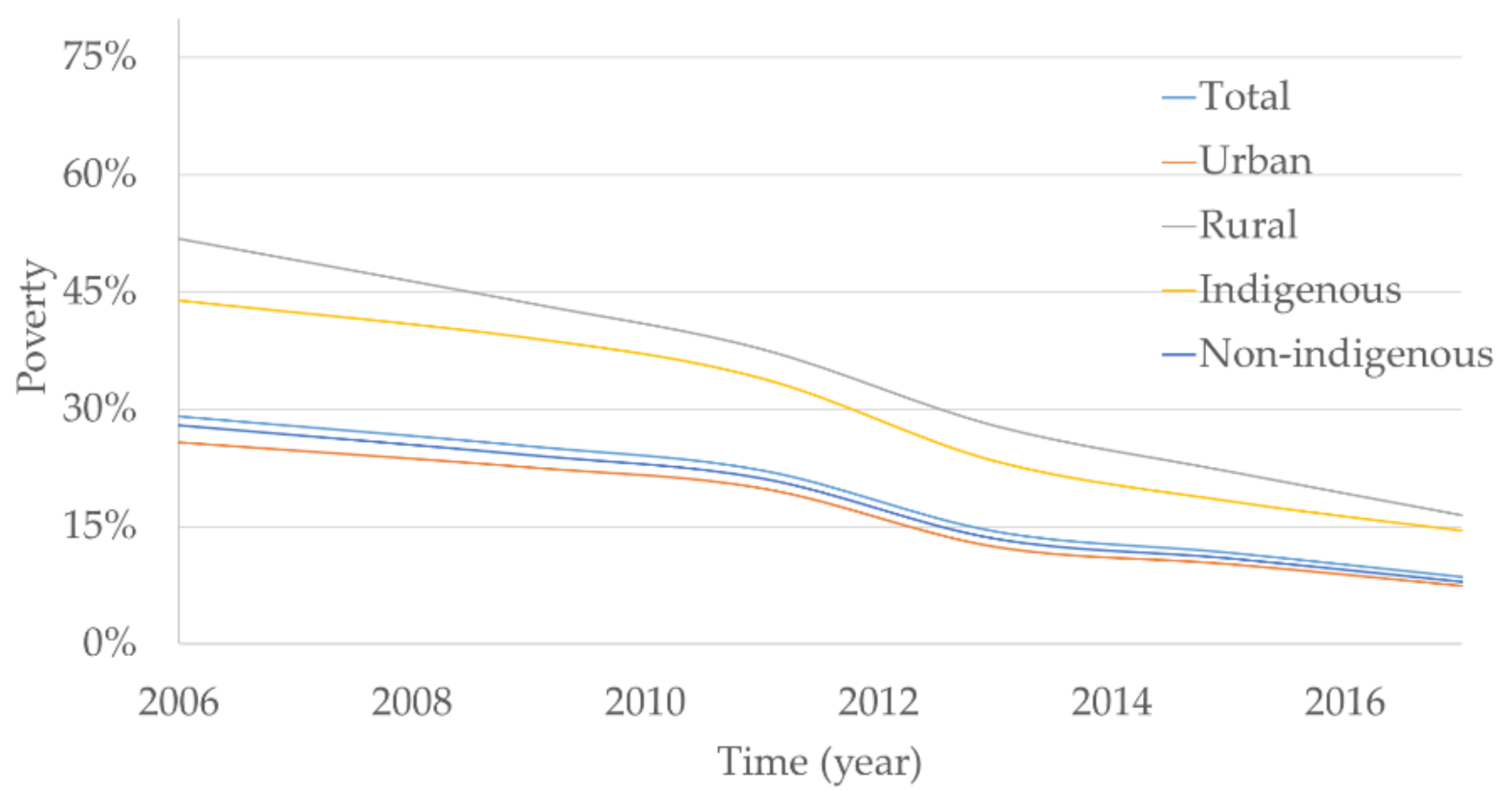
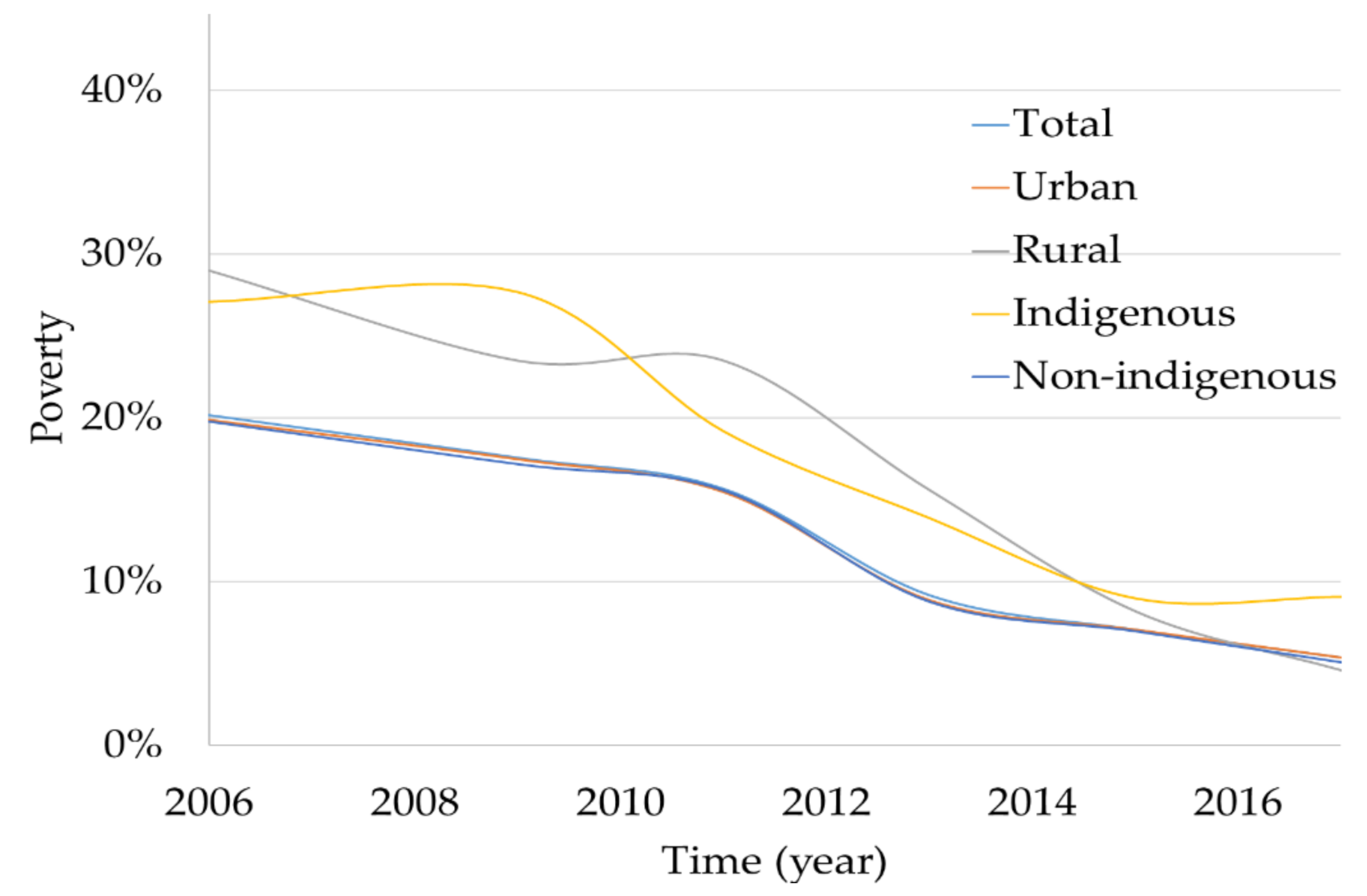

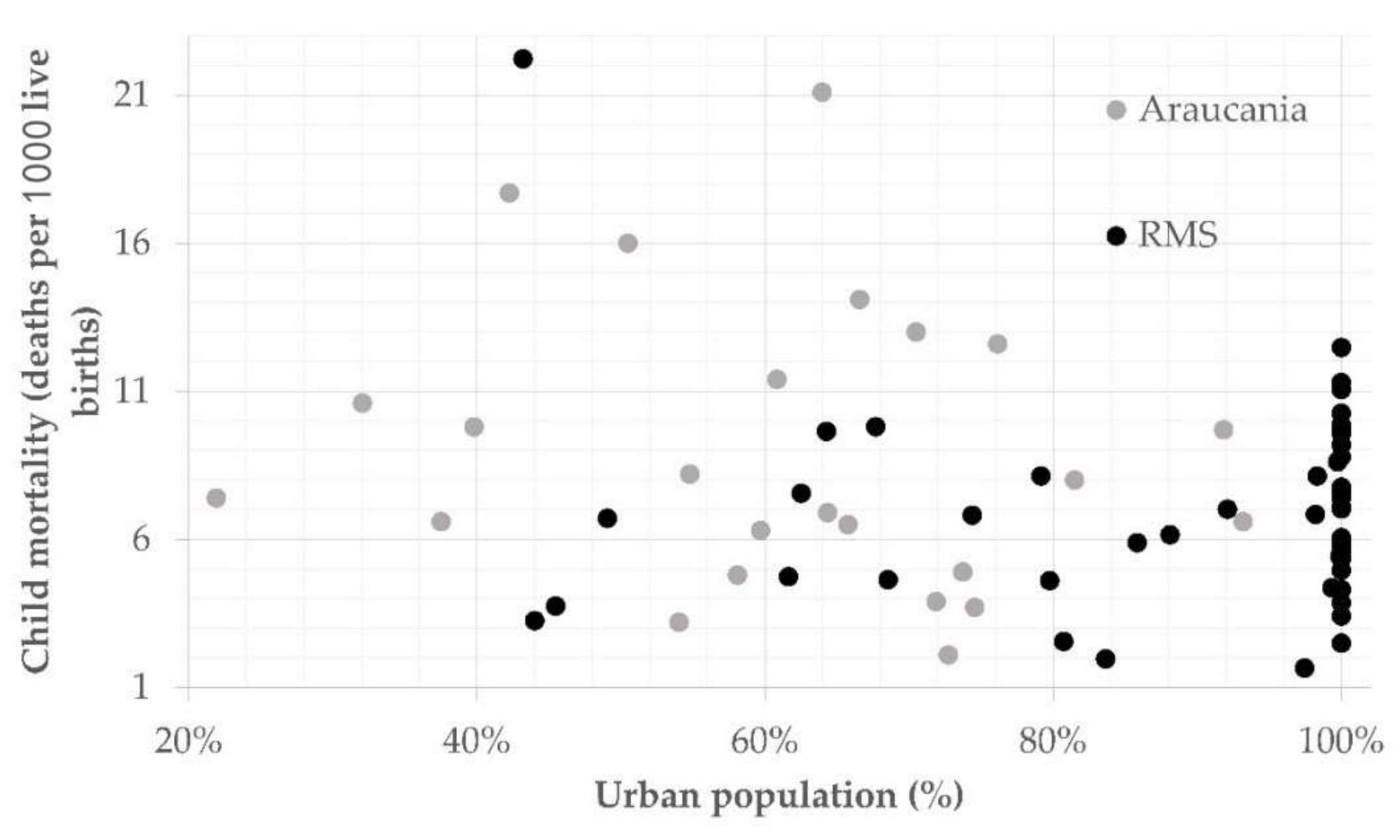
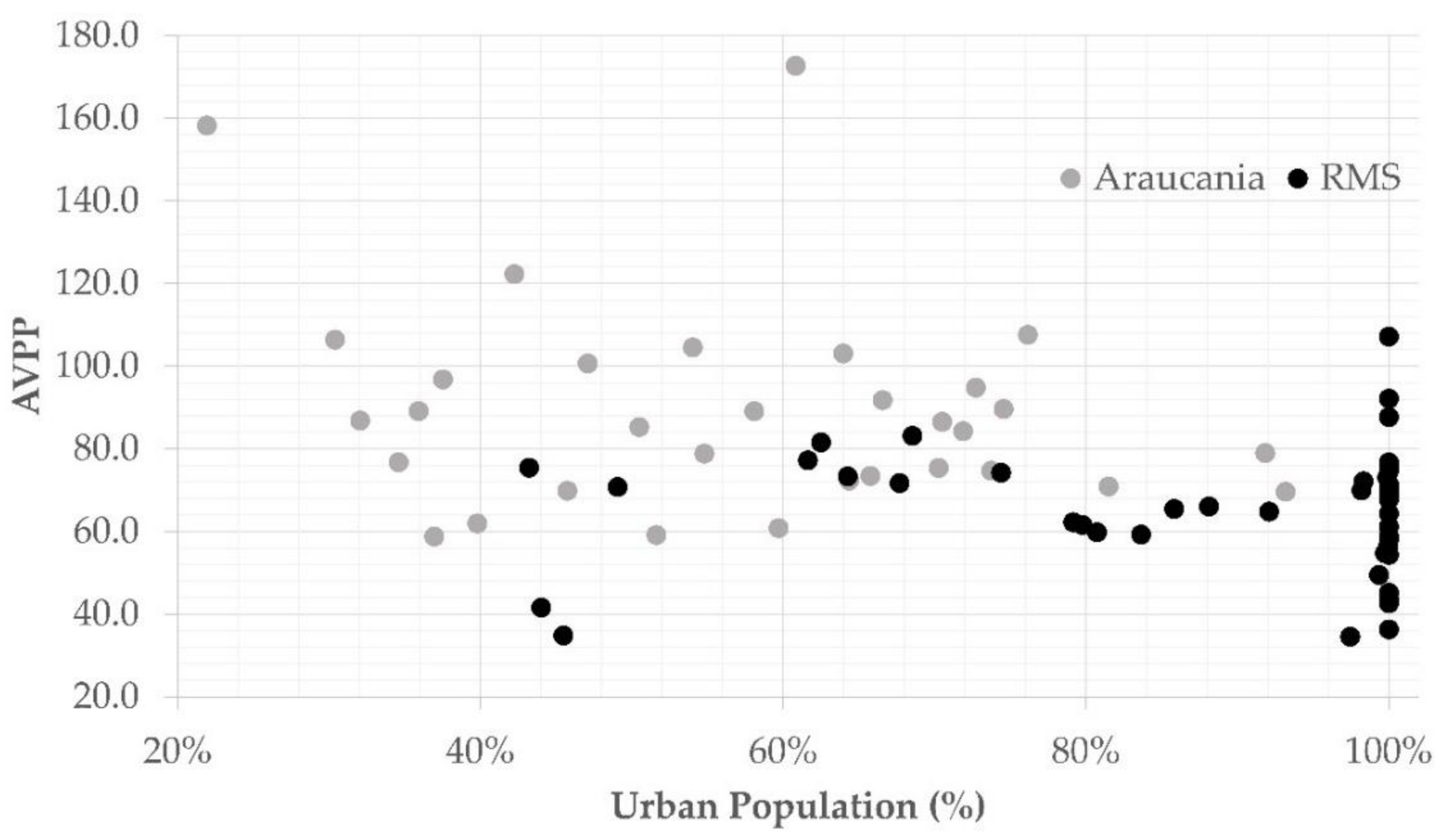
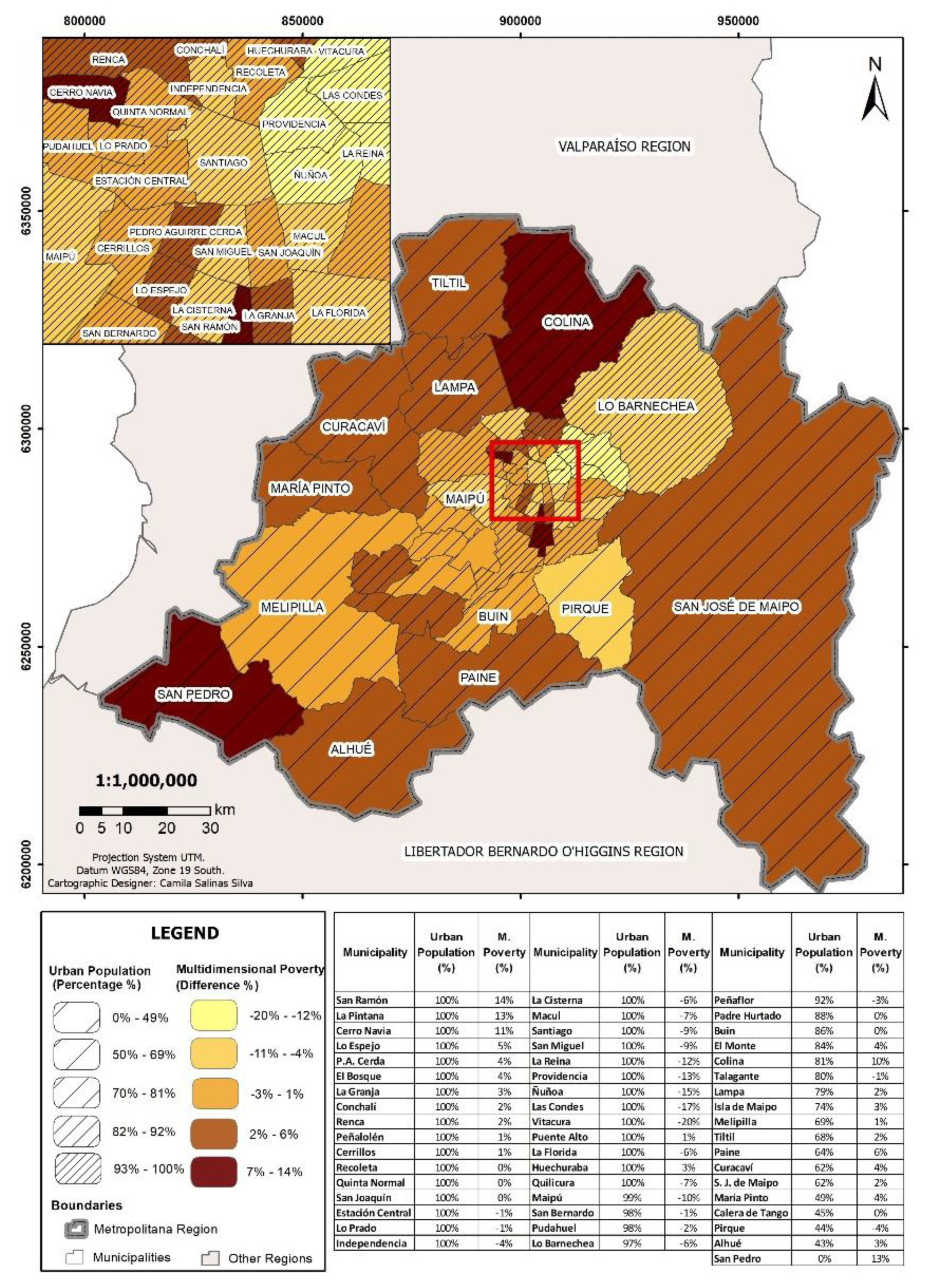
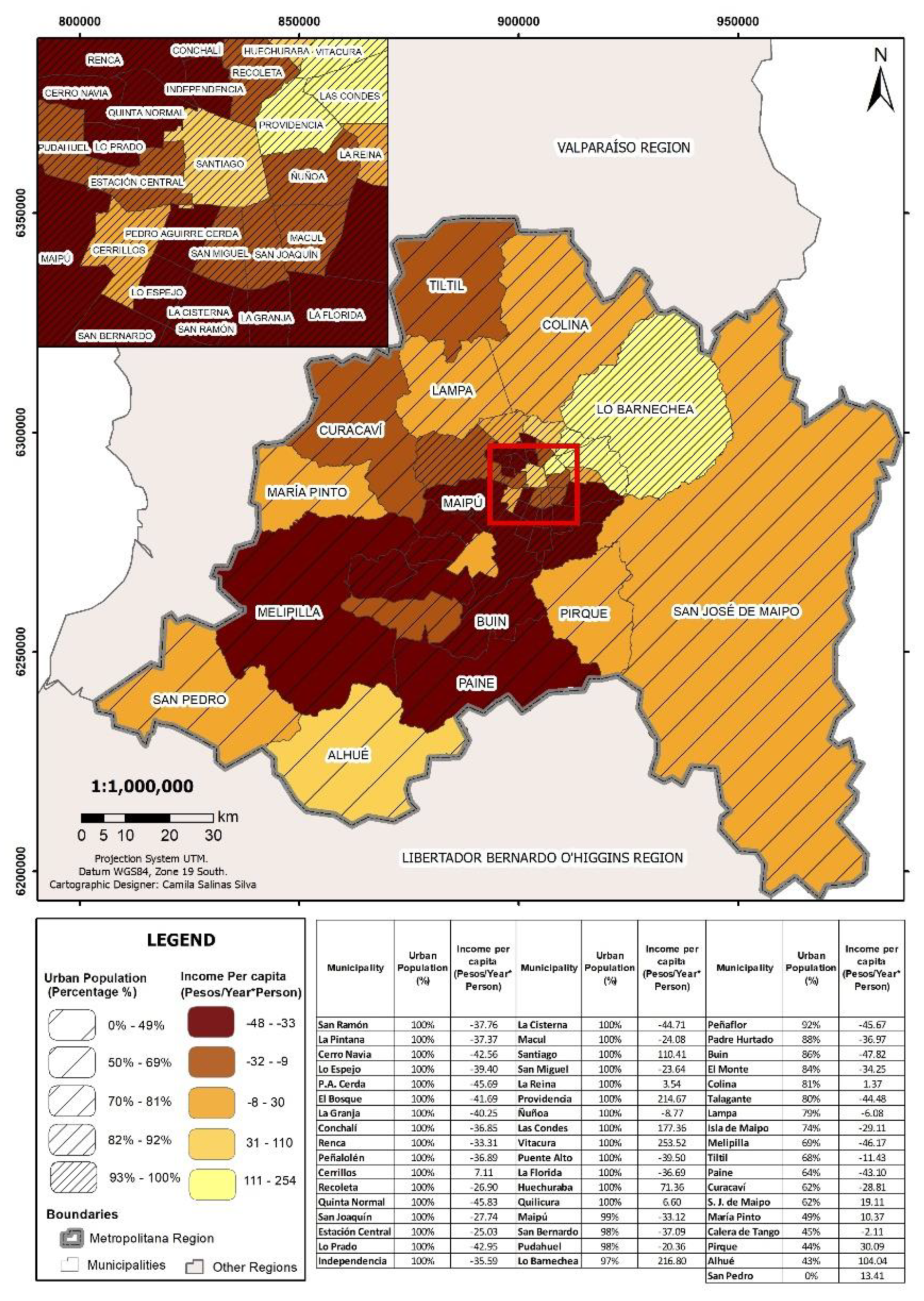
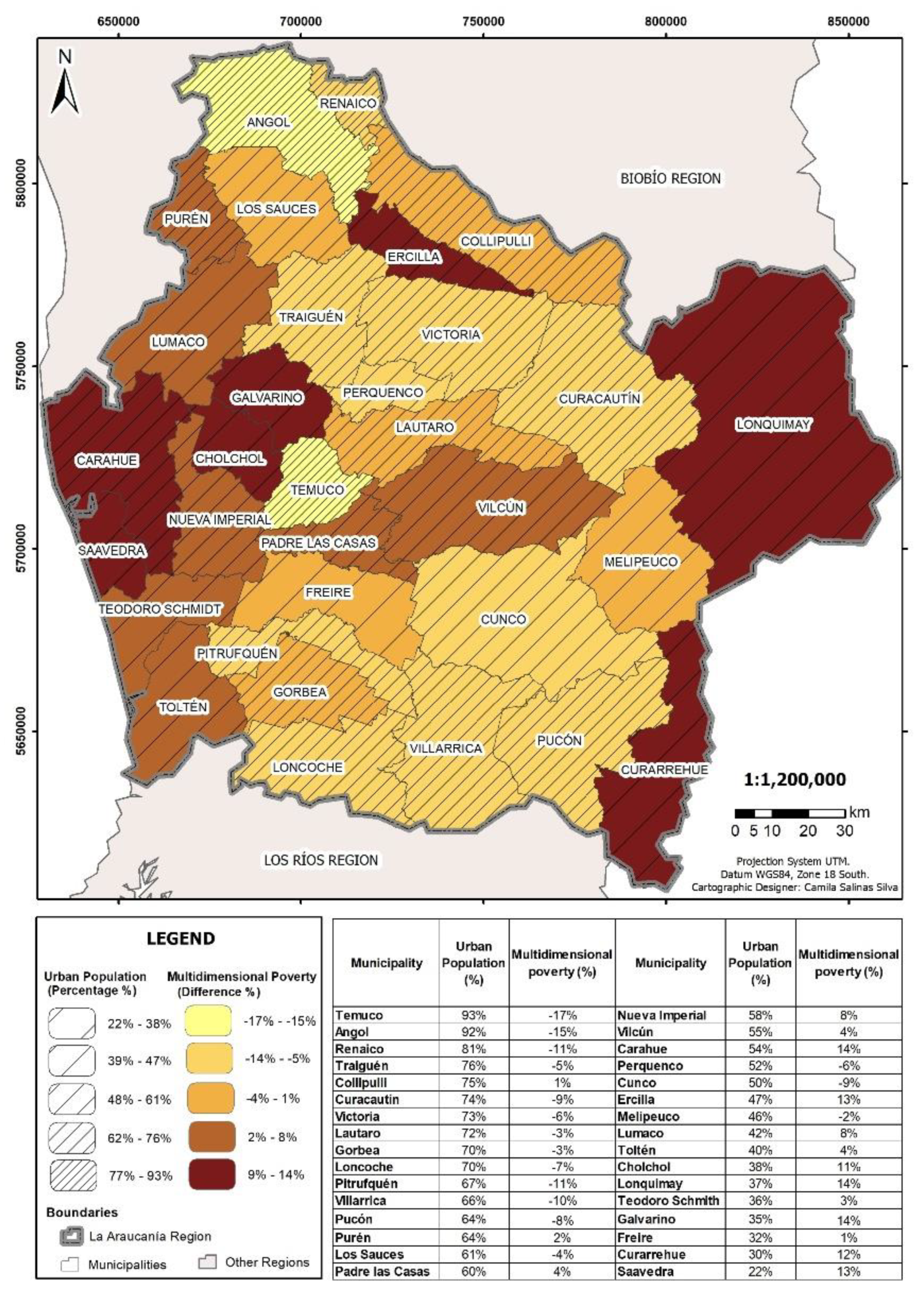
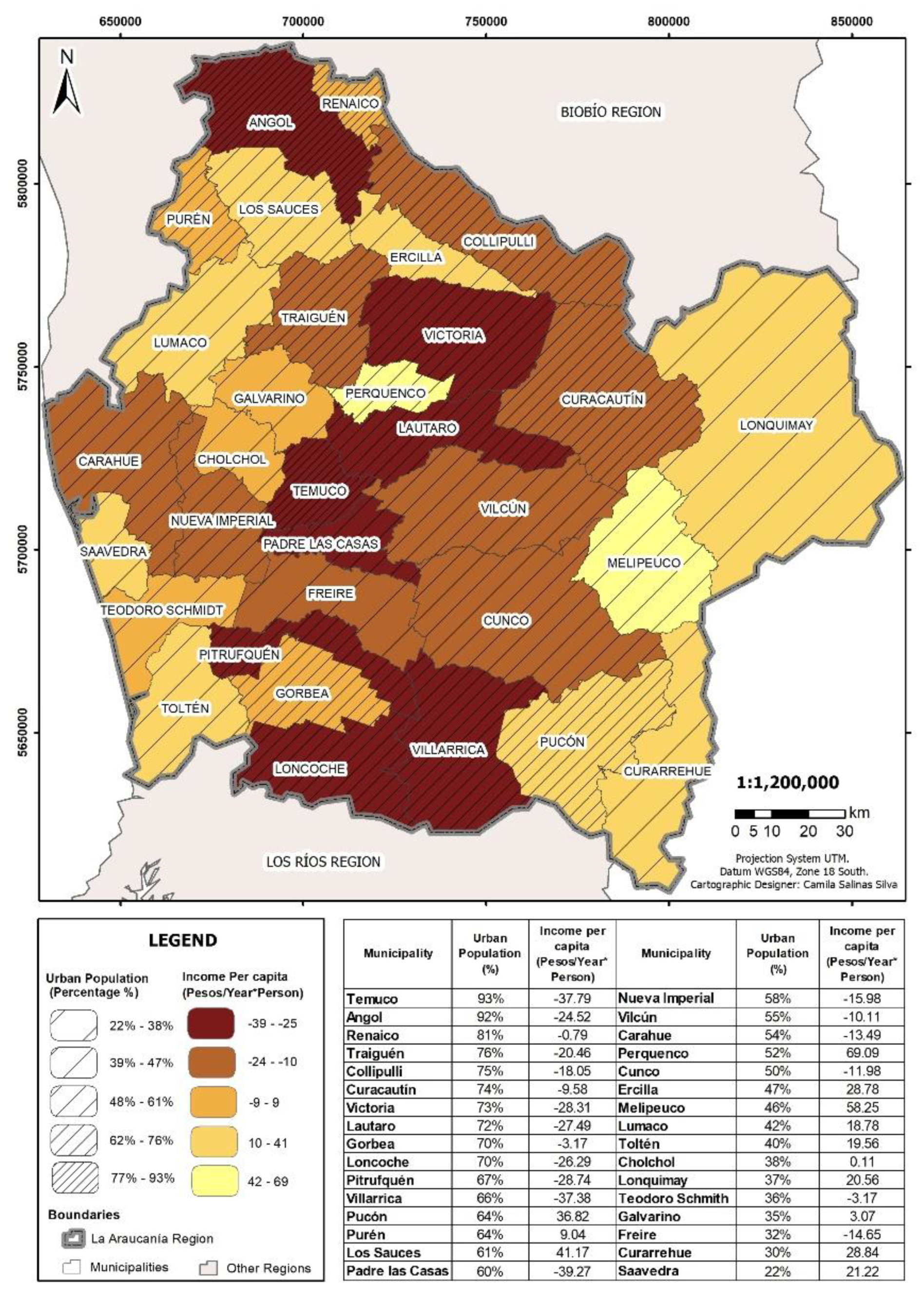
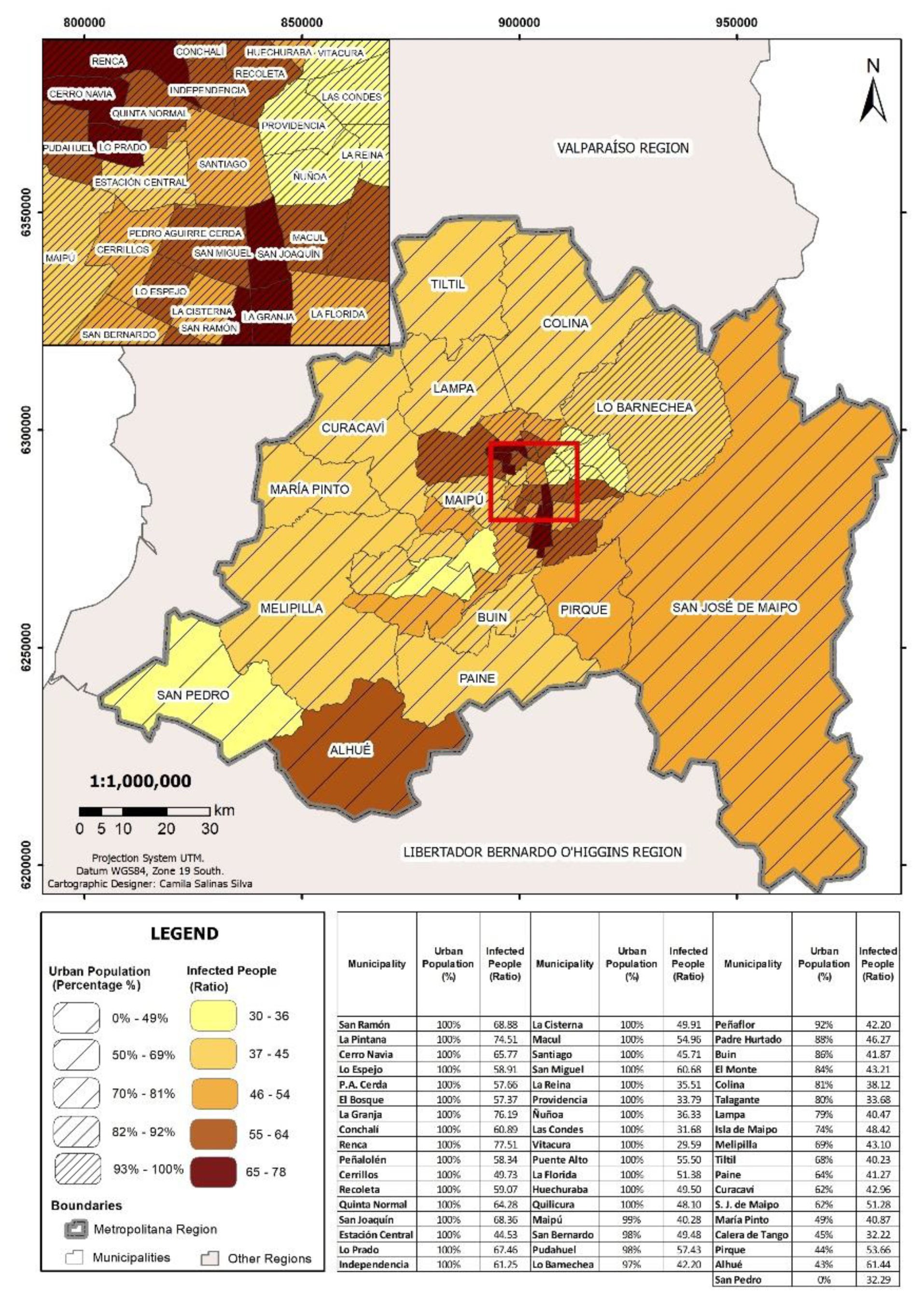
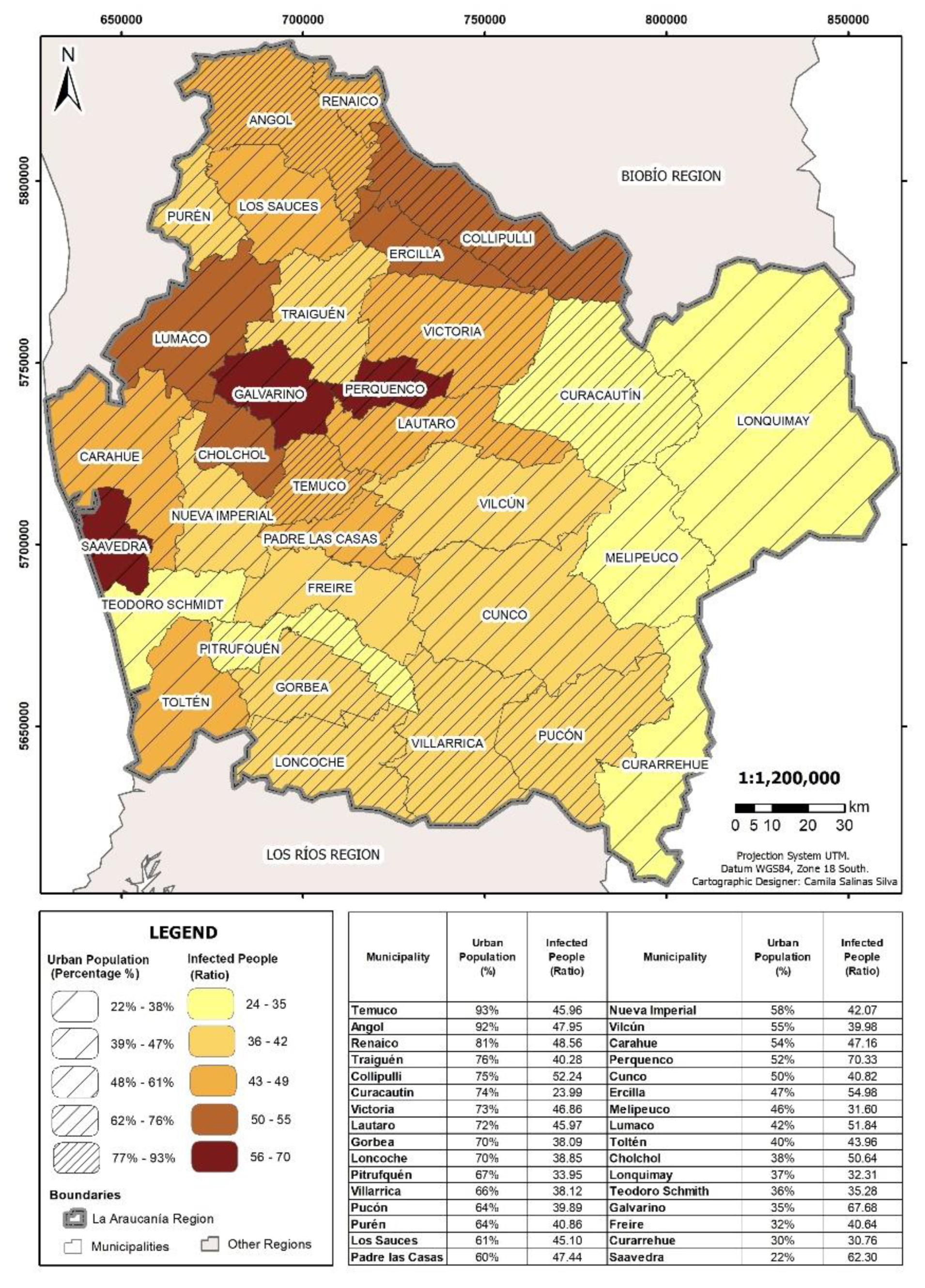
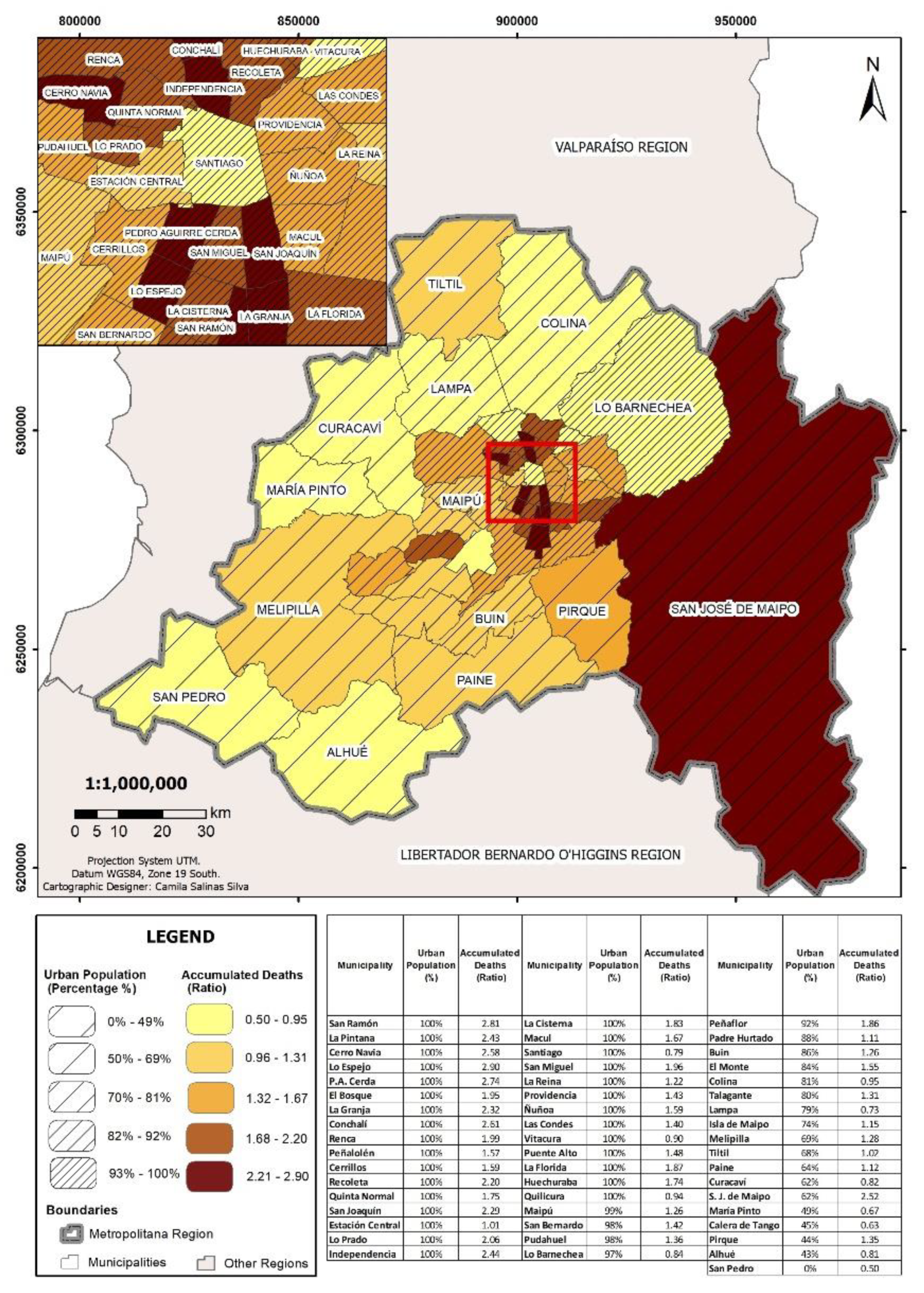
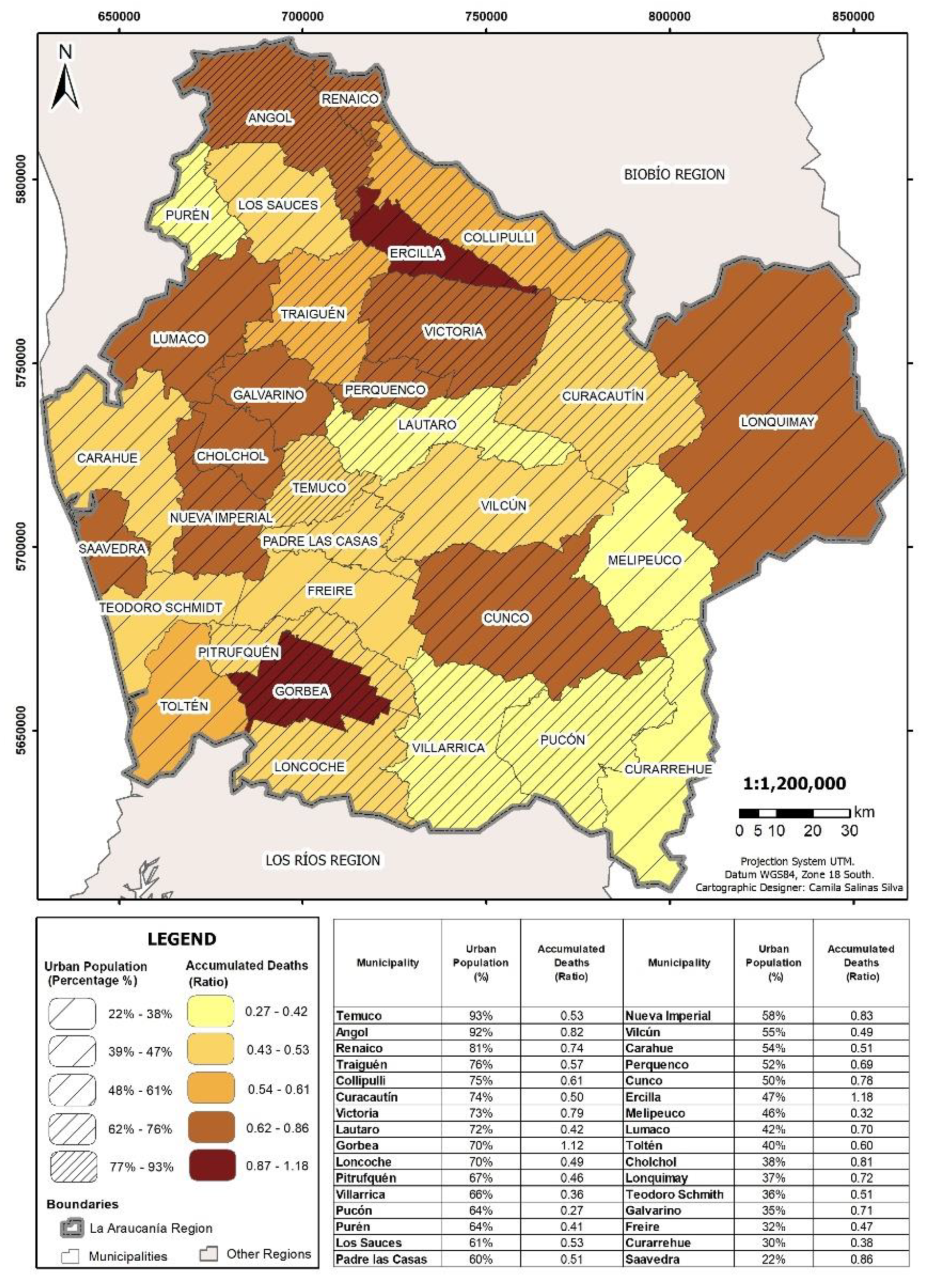
| Indicator | Unit | Scale | Source | Period | Calculation |
|---|---|---|---|---|---|
| Poverty | % low-income people in the total population | Regional and municipal | CASEN (National Socio-Economic Characterization Survey), Ministry of Social Development and Family | Regional 2006–2017 | Poverty by income [89] |
| Multidimensional Poverty | % multidimensional poverty experienced in the total population | Regional and municipal | CASEN | 2013–2017 | Contemplates five dimensions: (1) education, (2) health, (3) work and social security, (4) housing and environment, and (5) networks and social cohesion (thus covering some cultural aspects of the community) [90] |
| AVPP (Years of potential life lost) | Ratio | Regional and municipal | DEIS (Department of Health Statistics and Information), Ministry of Health | 2001–2016 | Loss suffered as a result of premature death (before age 80). The AVPP rate is reported per 1000 population aged 0–79 years [91] |
| Infant mortality | Ratio | Regional and municipal | DEIS | 2001–2016 | Ratio of deaths of children under one year of age per thousand live births [91] |
| Municipality spending | Chilean pesos per capita, annual | Regional and municipal | SINIM (Municipal Information System) and INE (National Institute for Statistics) | 2001–2017 | Ratio between self-generated income and FCM transfers (Common Municipal Fund) by capita of the municipal population, according to INE 2002–2012–2017. |
| Covid—Infected | Ratio | Regional and municipal | DEIS | March 2020–March 2021 | Ratio of infected population to total population (per 1000) |
| Covid—Deaths | Ratio | Regional and municipal | DEIS | June 2020–March 2021 | Ratio of deaths to total population (per 1000) |
| Data Analysis | Reg. | 2000 | 2003 | 2005 | 2006 | 2009 | 2010 | 2011 | 2013 | 2015 | 2016 |
|---|---|---|---|---|---|---|---|---|---|---|---|
| Child M.—SD | RMS | 3.5 | 3.3 | 3.3 | 3.1 | 3.2 | 2.9 | 2.7 | 2.1 | 2.8 | 3.4 |
| Ara | 7.5 | 8.1 | 6.3 | 5.7 | 6.1 | 7.5 | 5.8 | 5.2 | 5.9 | 5.4 | |
| Child M.—Average (1000 live births) | RMS | 8.5 | 8.0 | 8.1 | 8.0 | 7.9 | 7.3 | 8.1 | 6.8 | 6.6 | 6.9 |
| Ara | 12.7 | 12.2 | 9.7 | 9.6 | 10.8 | 11.7 | 10.0 | 9.1 | 9.0 | 8.0 | |
| AVPP—SD | RMS | 16.7 | 21.8 | 18.9 | 19.4 | 25.7 | 28.8 | 24.6 | 14.8 | 15.7 | 14.4 |
| Ara | 19.9 | 23.4 | 17.9 | 20.0 | 23.4 | 21.1 | 18.1 | 15.3 | 20.9 | 25.4 | |
| AVPP—Average | RMS | 74.2 | 73.6 | 72.4 | 72.8 | 76.8 | 78.8 | 76.7 | 68.0 | 66.4 | 65.7 |
| Ara | 94.7 | 99.1 | 96.5 | 88.7 | 92.6 | 93.7 | 91.0 | 85.3 | 85.3 | 89.1 | |
| M. Inc.—SD | RMS | ----- | 43.9 | 47.0 | 50.0 | 57.8 | 58.2 | 69.8 | 80.4 | 122.4 | 106.4 |
| Ara | ----- | 14.0 | 18.4 | 26.9 | 25.5 | 24.3 | 28.0 | 31.1 | 36.4 | 42.9 | |
| M. Inc.—Average (M$ per capita) | RMS | ----- | 66.1 | 71.5 | 78.7 | 97.9 | 99.0 | 110.9 | 125.7 | 186.7 | 165.4 |
| Ara | ------ | 56.9 | 65.7 | 74.3 | 102.1 | 104.3 | 117.0 | 134.4 | 168.1 | 184.2 |
| Ratio | Function | Unit | RMS | Araucania |
|---|---|---|---|---|
| Infected | Average | N° affected per 1000 people | 50.31 | 44.26 |
| Median | 49.49 | 43.01 | ||
| DS | 12.32 | 10.12 | ||
| Range | 25.59–77.51 | 23.99–70.33 | ||
| Deaths | Average | 1.57 | 0.61 | |
| Median | 1.45 | 0.55 | ||
| DS | 0.64 | 0.21 | ||
| Range | 0.50–2.90 | 0.27–1.18 |
Publisher’s Note: MDPI stays neutral with regard to jurisdictional claims in published maps and institutional affiliations. |
© 2021 by the authors. Licensee MDPI, Basel, Switzerland. This article is an open access article distributed under the terms and conditions of the Creative Commons Attribution (CC BY) license (https://creativecommons.org/licenses/by/4.0/).
Share and Cite
Barton, J.R.; Gutiérrez-Antinopai, F.; Escalona Ulloa, M. Adaptive Capacity as Local Sustainable Development: Contextualizing and Comparing Risks and Resilience in Two Chilean Regions. Sustainability 2021, 13, 4660. https://doi.org/10.3390/su13094660
Barton JR, Gutiérrez-Antinopai F, Escalona Ulloa M. Adaptive Capacity as Local Sustainable Development: Contextualizing and Comparing Risks and Resilience in Two Chilean Regions. Sustainability. 2021; 13(9):4660. https://doi.org/10.3390/su13094660
Chicago/Turabian StyleBarton, Jonathan R., Felipe Gutiérrez-Antinopai, and Miguel Escalona Ulloa. 2021. "Adaptive Capacity as Local Sustainable Development: Contextualizing and Comparing Risks and Resilience in Two Chilean Regions" Sustainability 13, no. 9: 4660. https://doi.org/10.3390/su13094660
APA StyleBarton, J. R., Gutiérrez-Antinopai, F., & Escalona Ulloa, M. (2021). Adaptive Capacity as Local Sustainable Development: Contextualizing and Comparing Risks and Resilience in Two Chilean Regions. Sustainability, 13(9), 4660. https://doi.org/10.3390/su13094660





